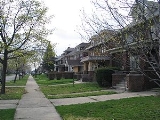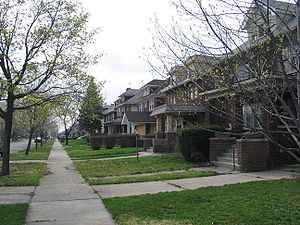
Atkinson Avenue Historic District
Encyclopedia
Atkinson Avenue is an east/west street located in the geographic heart of the city of Detroit, Michigan
.
 Atkinson Avenue was named in honor of William Francis Atkinson. Held prisoner by the Confederacy
Atkinson Avenue was named in honor of William Francis Atkinson. Held prisoner by the Confederacy
, Atkinson courageously escaped and rose to the rank of captain before leaving the service in 1886. Captain Atkinson had a commendable war record. Long after the Civil War
, he studied law and was admitted to the bar.
In its entirety, Atkinson Avenue begins at Woodward Avenue and travels westerly to Linwood Avenue, where Atkinson Avenue abruptly stops. Atkinson Avenue resumes at Savery Avenue and continues traveling westerly to its final terminus at McQuade Avenue, just west of Dexter Boulevard. For a time, during the 1890's, that portion of Atkinson Avenue situated between 12th Street and "Crawford" Street (later re-named "Hamilton"), actually constituted a part of the boundary of Detroit's city limits.
Atkinson Avenue consists of parts of six subdivisions, specifically Joy Farm, Lewis Park, Jackson Park, Voigt Park, Boston Boulevard, and Guerold’s Subdivision. The adjacent Boston-Edison Historic District
is composed of the same subdivisions. The Atkinson Avenue Historic District, however, only includes those six blocks of Atkinson Avenue situated between the John C. Lodge Expressway and Linwood Avenue. The Atkinson Avenue Historic District, as it exists today, was established by action of the Detroit City Council in March of 1984 (Journal City Council 262 66, passed March 7, 1984 and effective March 26, 1984). All remaining portions of Atkinson Avenue are not within the boundaries of any historic district.
Of those portions not already within the city limits, the remaining land in the vicinity was incorporated into the City of Detroit by 1915. The peak building time for the area was 1915 to 1925, which corresponded to the construction of Henry Ford Hospital
—several blocks to the south—in 1915. The neighborhood became a middle-class area of very nice homes. Doctors, ministers, real estate agents, salesmen and a newspaper writer were among the community’s first residents. One of the thoroughfare's most well-known residents was the renowned baseball player Ty Cobb
who resided in a brick dwelling at the intersection of Atkinson and Third (not within the boundaries of the historic district).
Each of the aforementioned subdivisions had similar building restrictions. Homes were to be built 30 feet from the front of the lot line and building materials were to be solid brick, stone, cement, stone veneer or stucco. Few dwellings were of wooden frame construction. All residences were to have full basements. Most houses are of the "basic box" or "four square" types with Mediterranean, Colonial or Tudor elements and are two stories tall with an attic. If a home had an ornamental fence, it was to be of no more than five feet in height.
Cost of construction was also specified to be between $3,000 to $4,000. The majority of homes were to be single-family residences. Unlike other neighborhoods within the city, Atkinson Avenue residents did not file deed restrictions prohibiting non-Caucasians from purchasing homes.
Michigan
Michigan is a U.S. state located in the Great Lakes Region of the United States of America. The name Michigan is the French form of the Ojibwa word mishigamaa, meaning "large water" or "large lake"....
.

Confederate States Army
The Confederate States Army was the army of the Confederate States of America while the Confederacy existed during the American Civil War. On February 8, 1861, delegates from the seven Deep South states which had already declared their secession from the United States of America adopted the...
, Atkinson courageously escaped and rose to the rank of captain before leaving the service in 1886. Captain Atkinson had a commendable war record. Long after the Civil War
American Civil War
The American Civil War was a civil war fought in the United States of America. In response to the election of Abraham Lincoln as President of the United States, 11 southern slave states declared their secession from the United States and formed the Confederate States of America ; the other 25...
, he studied law and was admitted to the bar.
In its entirety, Atkinson Avenue begins at Woodward Avenue and travels westerly to Linwood Avenue, where Atkinson Avenue abruptly stops. Atkinson Avenue resumes at Savery Avenue and continues traveling westerly to its final terminus at McQuade Avenue, just west of Dexter Boulevard. For a time, during the 1890's, that portion of Atkinson Avenue situated between 12th Street and "Crawford" Street (later re-named "Hamilton"), actually constituted a part of the boundary of Detroit's city limits.
Atkinson Avenue consists of parts of six subdivisions, specifically Joy Farm, Lewis Park, Jackson Park, Voigt Park, Boston Boulevard, and Guerold’s Subdivision. The adjacent Boston-Edison Historic District
Boston-Edison Historic District
The Boston-Edison Historic District is a historic neighborhood located in the geographic center of Detroit, Michigan. It consists of over 900 homes built on four east/west streets: West Boston Boulevard, Chicago Boulevard, Longfellow Avenue, and Edison Avenue, stretching from Woodward Avenue on...
is composed of the same subdivisions. The Atkinson Avenue Historic District, however, only includes those six blocks of Atkinson Avenue situated between the John C. Lodge Expressway and Linwood Avenue. The Atkinson Avenue Historic District, as it exists today, was established by action of the Detroit City Council in March of 1984 (Journal City Council 262 66, passed March 7, 1984 and effective March 26, 1984). All remaining portions of Atkinson Avenue are not within the boundaries of any historic district.
Of those portions not already within the city limits, the remaining land in the vicinity was incorporated into the City of Detroit by 1915. The peak building time for the area was 1915 to 1925, which corresponded to the construction of Henry Ford Hospital
Henry Ford Hospital
Henry Ford Hospital, the flagship facility for , is an 805-bed tertiary care hospital, education and research complex located in Detroit ....
—several blocks to the south—in 1915. The neighborhood became a middle-class area of very nice homes. Doctors, ministers, real estate agents, salesmen and a newspaper writer were among the community’s first residents. One of the thoroughfare's most well-known residents was the renowned baseball player Ty Cobb
Ty Cobb
Tyrus Raymond "Ty" Cobb , nicknamed "The Georgia Peach," was an American Major League Baseball outfielder. He was born in Narrows, Georgia...
who resided in a brick dwelling at the intersection of Atkinson and Third (not within the boundaries of the historic district).
Each of the aforementioned subdivisions had similar building restrictions. Homes were to be built 30 feet from the front of the lot line and building materials were to be solid brick, stone, cement, stone veneer or stucco. Few dwellings were of wooden frame construction. All residences were to have full basements. Most houses are of the "basic box" or "four square" types with Mediterranean, Colonial or Tudor elements and are two stories tall with an attic. If a home had an ornamental fence, it was to be of no more than five feet in height.
Cost of construction was also specified to be between $3,000 to $4,000. The majority of homes were to be single-family residences. Unlike other neighborhoods within the city, Atkinson Avenue residents did not file deed restrictions prohibiting non-Caucasians from purchasing homes.

